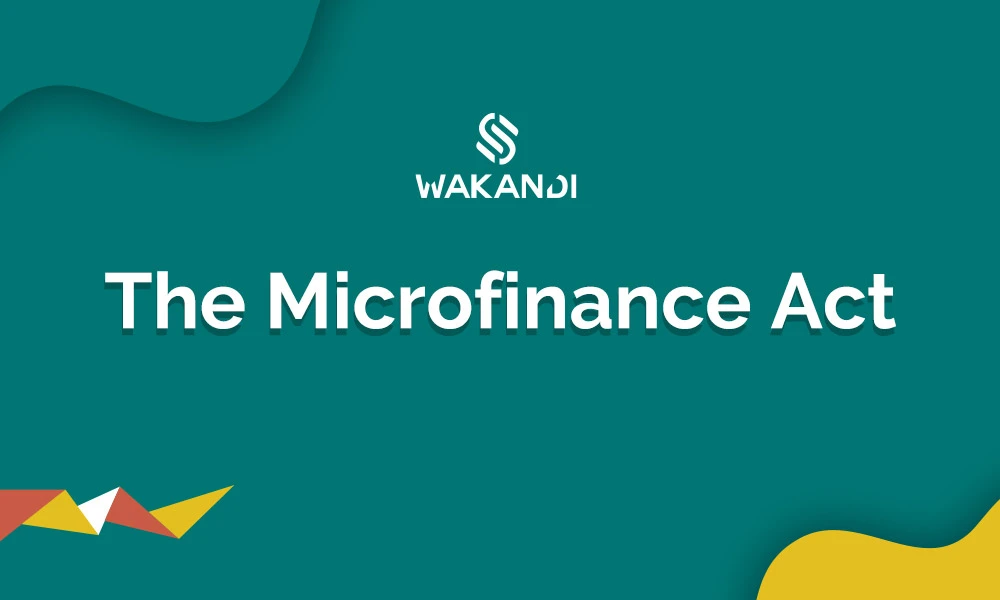Microfinance Act Kenya

Introduction
Kenyan microfinance sector is quite unlike the formal banking sector or like other microfinance sectors in the neighboring countries. In Kenya, the sector is regulated and supervised under different jurisdictions and laws. Because of that, it faces various challenges and constraints that might limit its role to achieve the desired level of outreach and sustainability. There are primary and secondary legislation regulating the microfinance industry in Kenya. Kenya issued separate laws to promote microfinance. Despite of that microfinance in Kenya is regulated under different laws, including the banking law and the Microfinance Act, which was issued in 2006 and amended in 2013.
Regulation
The Act applies to deposit-taking institutions; parts of the Act may be declared applicable to no-deposit-taking institutions in the future. Despite the low growth of the Kenyan economy in recent years, the country’s microfinance sector continues to evolve rapidly as shown previously for the years between 2006 and 2009.
The country encourages the introduction of communication technology. Consequently, mobile money services are being used widely in Kenyan communities. This innovation and rapid development of many local efforts driven by the demand side to provide financial services to microfinance clients unreached through the formal channels, seem to have generally overtaken policy formulation by the Kenyan government. The country recently encouraged the regulator to formulate a regulatory system for microfinance through mandated standards of performance that assist the financial sector in moving from a less-regulated environment to a tightly-regulated one.
Objective
Hence, the Microfinance Act 2006 and the Central Bank of Kenya Act primarily governed the industry. The main objective of the Microfinance Act is to provide the legal, regulatory and the supervisory framework for the Deposit-Taking Microfinance Institutions (DTMs). The Act categorises the Deposit-Taking MFIs as nationwide MFIs (operating countrywide) with a minimum core capital of KES 60M (USD 860,000) and Community MFIs (operating within a specific administrative region) whose minimum core capital is KES 20M (USD 300,000).
The Act makes provisions for MFI license issuance, revocation, and restriction; provides for MFI entry into regulated status; defines the minimum core capital requirements and prohibited activities; provides limits for loans or credit facilities; defines ownership and management structure; provides for supervision by CBK; and stipulates the terms for periodic reporting to the CBK.
The Microfinance (Amendment) Bill 2013 increased the range of financial services that the DTMs can offer. Moreover, the amended version has differentiated between the regulated microfinance institutions and the un-regulated microfinance lenders. This was because the law requires the regulated MFIs to incorporate the term DTM into their names. Therefore, the amended Act enhances market confidence in Kenya’s microfinance sector. In addition, Section 14 of the Microfinance Bill gives DTMs the right to issue third party checks, operate current accounts, and perform foreign trade operations.
Supervision
There are two categories: Microfinance Banks and Credit-only MFIs.
- MFBs are regulated by CBK. Microfinance Act, 2006 and the Microfinance (Deposit Taking Institutions) Regulations 2008 issued thereunder sets out the legal, regulatory and supervisory framework for the microfinance industry in Kenya.
- The principal object of the Microfinance Act is to regulate the establishment, business and operations of microfinance
institutions in Kenya through licensing and supervision. - The Act enables Microfinance banks to mobilise savings from the general public, thus promoting competition, efficiency and access and play a pivotal role in deepening financial markets and enhancing access to financial services and products by majority of the Kenyans.
General penalty
A person who contravenes these Regulations commits an offence and is liable on conviction to a fine not exceeding one hundred thousand shillings or to imprisonment for a term not exceeding one year or to both.
The Act addresses the following topics:
- Licensing provisions. These include:
- Qualifications for carrying out deposit-taking microfinance business;
- Application, issuance, renewal, revocation and restriction of license;
- Provisions related to governance, such as:
- Minimum capital requirements and minimum liquid assets;
- Prohibited activities;
- Application for and limits on loans and credit facilities;
- Submission of accounts to the Central Bank;
- Provisions regarding the appointments and qualifications of an external auditor;
- Supervision by the Central Bank that includes:
- Inspection of institutions;
- The power of the Central Bank to intervene in management;
- Protection of deposits, including:
- Liquidation of an institution by the Central Bank;
- Rights of the Board on insolvency;
- Miscellaneous provisions that cover:
- Default by officers or employees
- Regulations and transitional provisions.
Are you running a SACCO or microfinance institute?
Get Microfinance Act of Kenya PDF right in your inbox.

Comments